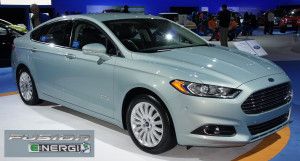
2013 Ford Fusion Energi SEL plug-in hybrid
Ford recently made an announcement regarding its plan to improve fuel efficiency by updating its Fusion sedan. In fact, the approximate EPA fuel figures of Fusion Energi have increased by about 10 percent. This increase computes to a fully electric mode driving range of 22 miles and a combined gasoline hybrid range of 42 mpg. Surprisingly, to achieve this state, the engineers altered everything apart from the lithium battery that maintains its 7.6kWh capacity. According to the automaker’s electric powertrain manager, plug-in cars such as Fusion Energi have a high sensitivity to parasitic losses. Hence, there was the need to pay close attention to detail so as to minimize friction as much as possible.
Similar to the battery-pack, the cylinder engine powering Fusion was that from the 2016 model regardless of the fact that the oil now has a reduced viscocity, necessary in minimizing internal friction. Just like several other hybrids, the Atkinson cycle is the mechanism under which Ford’s engine operates. This cycle is important in keeping open the intake vales as long as possible to give a short compression stroke. This way, the engine efficiency is improved and torque produced. To compensate the torque in question, the electric car system has off-the-line responsiveness with the most instant low-end torque.
One of the fundamental mechanical updates to the new version of the hybrid drive happens to be the car’s electric motor. Although the motor’s horsepower of 118 still remains the same, some redesigning has been made to the steel core. Additionally, the gauge steel is now thinner with a laminate structure. The end result is a significant decrease in eddy currents within the field of electromagnetism. Also, the efficiency of energy conversion generally goes up following such changes.
The aerodynamic experts have also dedicated their time to making the underbody covers smoother and more refined. This gives the car minimal resistance when slipping through air. Reworking has been done even to the piston seals located in the brake calipers. The approach in question might not work for non-hybrid cars because drivers would be forced to push brake pedals a further distance before making contact with the pads. However, a modern car that works on hybrid technology will not face such an issue. This is because a greater part of initial braking is done through a regenerative system, which plays the role of generating electricity from the vehicle’s kinetic energy. This energy is used for charging the battery needed to drive or run the car.